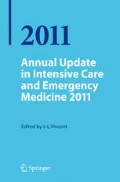Abstract
Cardiovascular insufficiency is characterized by an inadequate oxygen delivery (DO2) relative to metabolic demands. In the early stages of shock, compensatory autonomic mechanisms, such as vasoconstriction of muscles and skin and eventually lesser vital organs, are activated in an attempt to maintain central blood pressure and vital organ perfusion above an anaerobic threshold. Because in this stage of compensated shock macrocirculatory measures, like arterial pressure or cardiac output, are often inside the range of values defined as normal, these traditional measures of circulatory shock are insensitive as early predictors of subsequent decompensation. Patients in these states of compensated shock are at increased risk of tissue ischemia and subsequent development of multi-organ failure and death. Although macrocirculatory assessments are usually insensitive to assess compensated shock states, microcirculation alterations in muscle and skin blood flow already occur. Thus, measures of tissue cardiovascular reserve should be a sensitive early warning measure of impending cardiovascular collapse due to progressive hemorrhage presenting as compensated shock. In that regard, we present published and preliminary data demonstrating that the non-invasive measurement of tissue oxygen saturation (StO2) when coupled to a functional hemodynamic monitoring test, such as the vascular occlusion test, may allow early identification of compensated circulatory shock and thus guide initial resuscitation efforts.
Access this chapter
Tax calculation will be finalised at checkout
Purchases are for personal use only
Preview
Unable to display preview. Download preview PDF.
References
Cohn SM, Nathens AB, Moore FA, et al (2007) Tissue oxygen saturation predicts the development of organ dysfunction during traumatic shock resuscitation. J Trauma 62: 44–54
Crookes BA, Cohn SM, Bloch S, et al (2005) Can near-infrared spectroscopy identify the severity of shock in trauma patients. J Trauma 58: 806–813
Mesquida J, Masip J, Gili G, Artigas A, Baigorri F. (2009) Thenar oxygen saturation measured by near infrared spectroscopy as a noninvasive predictor of low central venous oxygen saturation in septic patients. Intensive Care Med 35: 1106–1109
Payen D, Luengo C, Heyer L, et al (2009) Is thenar tissue hemoglobin oxygen saturation in septic shock related to macrohemodynamic variables and outcome? Crit Care 13(Suppl 5): S6
Gomez H, Torres A, Polanco P, et al (2008) Use of non-invasive NIRS during vascular occlusion test to assess dynamic tissue O2 saturation response. Intensive Care Med 34: 1600–1607
Gomez H, Mesquida J, Simon P, et al (2009) Characterization of StO2 and VOT: Influence of measurement sites, probe sizes and deflation thresholds. Crit Care 13(Suppl 5): S3
De Backer D, Creteur J, Preiser JC, Dubois MJ, Vincent JL (2002) Microvascular blood flow is altered in patients with sepsis. Am J Respir Crit Care Med 166: 98–104
Sakr Y, Dubois MJ, De Backer D, Creteur J, Vincent JL (2004) Persistent microcirculatory alterations are associated with organ failure and death in patients with septic shock. Crit Care Med 34: 1825–1831
Creteur J, Carollo T, Soldati G, Buchele G, De Backer D, Vincent JL (2007) The prognostic value of muscle StO2 in septic patients. Intensive Care Med 33: 1549–1556
Guyette F, Gomez H, Suffoletto B, et al (2009) Prehospital dynamic tissue O2 saturation response predicts in-hospital mortality in trauma patients. Crit Care Med 37(suppl): A28 (abst)
Author information
Authors and Affiliations
Editor information
Editors and Affiliations
Rights and permissions
Copyright information
© 2011 Springer Science+Business Media LLC
About this chapter
Cite this chapter
Garcia, X., Guyette, F.X., Pinsky, M.R. (2011). Use of Non-invasive Tissue Oxygen Saturation Monitoring to Assess Cardiovascular Insufficiency. In: Vincent, JL. (eds) Annual Update in Intensive Care and Emergency Medicine 2011. Annual Update in Intensive Care and Emergency Medicine 2011, vol 1. Springer, Berlin, Heidelberg. https://doi.org/10.1007/978-3-642-18081-1_34
Download citation
DOI: https://doi.org/10.1007/978-3-642-18081-1_34
Publisher Name: Springer, Berlin, Heidelberg
Print ISBN: 978-3-642-18080-4
Online ISBN: 978-3-642-18081-1
eBook Packages: MedicineMedicine (R0)

